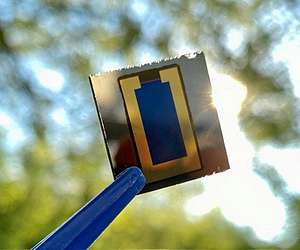Solar energy has been recognized as one of the promising green and renewable energy. Thanks to the synergistic innovation of active layer materials and device optimization techniques, organic solar cells (OSCs) have achieved great breakthroughs in the past decade and attracted widespread research attention. Though it could effectively realize solar energy conversion, it is still not mature enough for large-scale application.
Even though it is a challenge for OSCs to reconcile with the necessity for low-cost advantage compared with silicon or perovskite solar cells, there are lots of strategies to achieve high efficiency but low-cost OSCs via getting an in-depth understanding of the structure-property relationship of non-fused ring electron acceptors (NFREAs). A team of scientists summarized the considerable progress of NFREA-based OSCs in recent years. Their work is published in Industrial Chemistry and Materials on Nov. 17, 2022.
“The development of low-cost and high-efficiency photovoltaic devices is crucial for conquering the problem of energy crisis and environmental pollution,” said Xiangjian Wan, a Professor at Nankai University, “In this review, we systematically discussed the recent development of NFREA-based OSCs from the viewpoint of materials design, thus revealing the structure-property relationship to provide helpful guidance for material design and device optimization. We also provided an outlook on the remaining challenges to this field.”
Active layer materials, especially non-fullerene acceptors (NFAs) play a critical role in solar-to-electric conversion, which has greatly accelerated the advancement of device performances in OSCs. Among them, the fused ring electron acceptors, such as ITIC, Y6, and their analogous have proved to be the most successful NFAs and have achieved efficiencies of over 19%. This is mainly due to the good planarity and rigidity of those fused-ring acceptors, which can form stable geometric conformation and molecular packing.
However, most of the fused-ring acceptors suffer from complicated synthetic procedures and unsatisfactory reaction yields and thus high preparation costs, which will substantially limit future application. In contrast, the price of commercialized silicon-based solar cells has continuously decreased in recent years and low cost is the outstanding advantage of perovskite solar cells. Although OSC has many unique advantages, its cost issue has to be considered seriously for the commercialization of OSCs. Therefore, it is necessary and urgent to design active layer materials from the perspective of not only efficiency but also cost.
“NFREAs typically adopted C-C single bond instead of the fused-ring conjugated skeleton, which greatly simplified the synthesis process and generally generate high reaction yields, in comparison with that of fused ones,” Wan said,
“Presently, two efficient strategies have been established to suppress the torsion of C-C single bond and guarantee favorable planarity and rigid skeleton, that is to say the intramolecular non-covalent interaction by introducing suitable heteroatoms in the central core or the linking unit, and the steric hindrance by incorporating bulk side chains in the central core or the connecting unit.”
“NFREAs-based OSCs have achieved continuous progress in recent years,” explained Yongsheng Chen, a professor of Nankai University. “Following the similar design rationale of the widely used acceptor-donor-acceptor (A-D-A) architecture molecules that we have studied for over ten years, the state-of-the-art NFREAs can be roughly divided into A-p-D-p-A or A-p-A’-p-A architecture. Rational design and regulation of chemical structure of NFREAs could finely modulate the planarity, orientation, and packing properties, which exhibit the great potential to achieve a good balance between efficiency, cost, and even device stability,” Chen said.
There is still huge room for new NFREAs in future molecular design. It is suggested to further design NFREAs by synergistically utilizing intramolecular noncovalent interaction and large steric hindrance and develop other novel architecture other than A-p-D-p-A or A-p-A’-p-A.
Researchers think that new materials are still the most critical factor to promote the rapid development of OSC performances, especially for the NFREA-based ones. And a deep understanding of the relationship between material structure and performance could provide valuable guidance for the upcoming low-cost and high-efficiency OSCs.
“In this review, our main goal is to provide readers with timely and accurate latest research progress and materials design strategies in this field,” Chen said.
The research team includes Huanhuan Gao and Chenyang Han from Xi’an Shiyou University in China; and Xiangjian Wan and Yongsheng Chen from Nankai University.
This research is funded by the Hong Kong Scholar Program, Natural Science Foundation Research Project of Shaanxi Province, National Natural Science Foundation of China, and Tianjin City.
Research Report:Recent progress in non-fused ring electron acceptors for high performance organic solar cells
Related Links
Institute of Process Engineering, Chinese Academy of Sciences
All About Solar Energy at SolarDaily.com
|
We need your help. The SpaceDaily news network continues to grow but revenues have never been harder to maintain. With the rise of Ad Blockers, and Facebook – our traditional revenue sources via quality network advertising continues to decline. And unlike so many other news sites, we don’t have a paywall – with those annoying usernames and passwords. Our news coverage takes time and effort to publish 365 days a year. If you find our news sites informative and useful then please consider becoming a regular supporter or for now make a one off contribution. |
||
|
SpaceDaily Contributor $5 Billed Once credit card or paypal |
SpaceDaily Monthly Supporter $5 Billed Monthly paypal only |
|

![]()
Improving perovskite solar cell resistance to degradation
Lausanne, Switzerland (SPX) Jan 13, 2023
Perovskite solar cells (PSCs) can be made with low-cost materials, are highly efficient, can surpass traditional silicon solar cells, and have the potential to revolutionize renewable energy. However, one of the current drawbacks preventing their widespread use has is their lack of operational stability.
Now, scientists at EPFL and Sungkyunkwan University in Korea have found a way to improve the stability of PSCs. The researchers focused on the degradation of perovskite thin films, which can be da … read more
